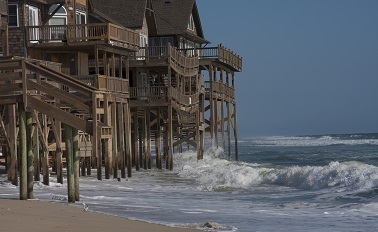
Source: Flickr/Jared Tarbell
If you think the weather’s acting strange, you’re correct. Extreme weather in the United States is trending upward, and human-caused climate change has already been blamed for much of it – most recently in connection with theCalifornia drought.
But along with extreme weather we’re also getting extreme contrasts. What on Earth is going on when New York gets endless rain and San Francisco none, and when one part of the country is freezing while another suffers under record heat?
You guessed it, rising temperatures have something to do with it – and here’s how.
Rain patterns are changing
In the Northeast, the combination of more moisture in the atmosphere from a warmer world and changes in circulation patterns are bringing more rain. In the Southwest, meanwhile, rainfall is suppressed by a northward expansion of high pressure in the subtropics.
The crippling drought now plaguing California is due to a persistent high pressure system off of the coast that is deflecting storms away from the region. A recent study shows that these systems are much more likely to occur with human-caused climate change.
Rain is more intense
Heavy downpours are controlled by cloud mechanisms and moisture content, which are both changing as global temperatures rise. Clouds that can dump a lot of rain are more common in a warmer atmosphere.
More evaporation has led to more moisture in the atmosphere which, in turn, leads to more intense rainfall when it rains. That helps explain why the entire U.S. is experiencing more heavy downpours – even in the drought-stricken West.
 Droughts are taking hold
Droughts are taking hold
Rain and evaporation will determine how moist the soil will be. So although evaporation is increasing nationwide due to warmer temperatures, higher precipitation in the Northeast yields a net increase in soil moisture in that part of the country.
In the Southwest, on the other hand, the drop in overall precipitation brings drier conditions that spawn or magnify drought. As the soil there dries out, the incoming sunlight will heat the ground instead of evaporating water from the soil. This creates a vicious cycle of more heat and less rain.
Flooding is more common
The potential for flooding, meanwhile, depends a lot on what’s going on with the soil. The higher the soil moisture content, the higher the chance that there will be more runoff from rainfall.
Because soil moisture is increasing in the Northeast, flooding events are on the rise. Fortunately for the region, many heavy rain storms occur in the summer and fall when soil moisture is low and the ground can absorb more water.
On the other hand, the sea level has risen by a foot since the 1900s in the Northeast. That, in turn, contributes to more flooding.
Disaster costs are also rising – but there is hope
In 2013, intense storms, severe regional drought, and extreme flooding led to more than $9 billion in disaster costs in the U.S. alone. It’s uncertain what the total bill was if you factor in ongoing agriculture, human health and infrastructure losses from changing weather conditions
Unless we curb emissions of heat-trapping gases, scientists expect these trends to continue and worsen – and the contrast between wet and dry areas of the U.S. will likely become even sharper. Our hope now is that the push for climate action amps up so we can finally set ourselves on a better path for the future.
This post originally appeared on EDF Voices











 Do you get a sense of déjà vu when you hear the fossil fuel industry arguments against the Environmental Protection Agency’s new climate change plan? You’re not imagining things – we’ve heard these many, many times before.
Do you get a sense of déjà vu when you hear the fossil fuel industry arguments against the Environmental Protection Agency’s new climate change plan? You’re not imagining things – we’ve heard these many, many times before.
